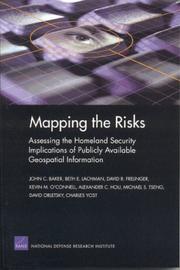| Listing 1 - 10 of 11 | << page >> |
Sort by
|

ISBN: 0195090276 Year: 1994 Publisher: New York Oxford Oxford University Press
Abstract | Keywords | Export | Availability | Bookmark
 Loading...
Loading...Choose an application
- Reference Manager
- EndNote
- RefWorks (Direct export to RefWorks)

ISBN: 1612342655 9781612342658 1574887335 9781574887334 Year: 2004 Publisher: Washington, D.C. Brassey's
Abstract | Keywords | Export | Availability | Bookmark
 Loading...
Loading...Choose an application
- Reference Manager
- EndNote
- RefWorks (Direct export to RefWorks)
Be prepared against terrorist attacks
Book
ISBN: 1614703426 9781614703426 9781606923559 1606923552 9781606923542 Year: 2009 Publisher: New York Nova Science
Abstract | Keywords | Export | Availability | Bookmark
 Loading...
Loading...Choose an application
- Reference Manager
- EndNote
- RefWorks (Direct export to RefWorks)

ISBN: 1283597306 9786613909756 083303622X 0833035479 9780833036223 9780833035479 9781283597302 6613909750 Year: 2004 Publisher: Santa Monica, CA Rand Corp.
Abstract | Keywords | Export | Availability | Bookmark
 Loading...
Loading...Choose an application
- Reference Manager
- EndNote
- RefWorks (Direct export to RefWorks)
Following the attacks of September 11, 2001, many agencies within the federal government began restricting some of their publicly available geospatial data and information from such sources as the World Wide Web. As time passes, however, decisionmakers have begun to ask whether and how such information specifically helps potential attackers, including terrorists, to select U.S. homeland sites and prepare for better attacks. The research detailed in this book aims to assist decisionmakers tasked with the responsibility of choosing which geospatial information to make available and which to rest
Civil defense--United States. --- Geographic information systems--Defense measures--United States. --- Civil defense --- Geographic information systems --- Defense measures --- Geographical information systems --- GIS (Information systems) --- Homeland defense --- Homeland security --- Information storage and retrieval systems --- Geography
Book
ISBN: 1489984038 1441903704 9786612361654 1282361651 1441903712 Year: 2009 Publisher: New York, NY : Springer Science,
Abstract | Keywords | Export | Availability | Bookmark
 Loading...
Loading...Choose an application
- Reference Manager
- EndNote
- RefWorks (Direct export to RefWorks)
This book brings together the technological and managerial innovations suggested and applied by the nation’s leading governors and mayors in their own words. It includes models for public-private partnerships to improve preparation for, response and recovery from major natural disasters and terrorist attacks. These leaders in innovation point out how the 9/11 communication problems that contributed to the catastrophe have been addressed, including the use of volunteer agencies and volunteers to supplement governmental efforts, which is a recurring theme of the book. The book makes specific recommendations of services usually provided by public emergency agencies that are private in nature and could be shed by government while often being provided by the private sector. The book further suggests public services that are under the responsibility of governments but could be delivered more efficiently by contracting them out under competitive conditions and highlights incentives for greater involvement of the private sector in the delivery of emergency services.
Civil defense -- United States. --- National security -- United States. --- National security --- Civil defense --- Management Theory --- Armies --- Military & Naval Science --- Management --- Law, Politics & Government --- Business & Economics --- Homeland defense --- Homeland security --- Business. --- Organization. --- Planning. --- Management. --- Industrial management. --- Political science. --- Regional economics. --- Spatial economics. --- Business and Management. --- Innovation/Technology Management. --- Political Science. --- Regional/Spatial Science.
Book
ISBN: 0833051121 0833051032 9780833051127 9780833051035 Year: 2010 Publisher: Santa Monica, CA RAND Corp.
Abstract | Keywords | Export | Availability | Bookmark
 Loading...
Loading...Choose an application
- Reference Manager
- EndNote
- RefWorks (Direct export to RefWorks)
Since the 9/11 terrorist attacks, the need for increased counterterrorism (CT) and homeland security (HS) efforts at the federal, state, and local levels has taken the spotlight in public safety efforts. In the immediate aftermath of 9/11, many law enforcement agencies (LEAs) shifted more resources toward developing CT and HS capabilities, and the federal government continues to support these efforts with grants provided through the Department of Homeland Security. This monograph examines the long-term adjustments that large urban LEAs have made to accommodate the focus on CT and HS, as well as the advantages and challenges associated with it. The study relies primarily on in-depth case studies of five large urban LEAs, as well as a review of federal HS grant programs and a quantitative analysis of the potential costs associated with shifting law enforcement personnel from traditional policing to focus on HS and CT functions. Major trends among the five case study LEAs include the creation of specialized departments and units, as well as an increased emphasis on information-sharing, which, nationwide, has led to the creation of fusion centers that serve as formal hubs for regional information-sharing networks. LEAs' HS and CT efforts are also greatly influenced by the restrictions and requirements associated with federal HS grant funding. Finally, using cost-of-crime estimates, it is possible to partially quantify the costs associated with LEAs' shifting of personnel away from traditional crime prevention toward CT and HS -- there are also clear benefits associated with law enforcement's focus on CT and HS, but they are difficult to quantify, and this is posing a challenge for LEAs as the economic downturn puts pressure on public budgets.
Civil defense --United States. --- Law enforcement --United States. --- National security --United States. --- Police training --United States --Costs. --- Terrorism --United States --Prevention. --- Terrorism --- National security --- Police training --- Law enforcement --- Civil defense --- Social Welfare & Social Work --- Criminology, Penology & Juvenile Delinquency --- Social Sciences --- Prevention --- Costs --- Prevention. --- Costs. --- Homeland defense --- Homeland security --- Police --- Training of --- Police professionalization --- Training
Book
ISBN: 1281736759 083304821X 0833045016 9780833045010 9780833047847 0833047841 9786611736750 6611736751 9780833044037 0833044036 9780833048219 9781281736758 Year: 2008 Publisher: Santa Monica, Calif. RAND
Abstract | Keywords | Export | Availability | Bookmark
 Loading...
Loading...Choose an application
- Reference Manager
- EndNote
- RefWorks (Direct export to RefWorks)
One of the questions in the fight against terrorism is whether the United States needs a dedicated domestic intelligence agency separate from law enforcement, on the model of many comparable democracies. To examine this issue, Congress directed that the Department of Homeland Security perform an independent study on the feasibility of creating a counterterrorism intelligence agency and the department turned to the RAND Corporation for this analysis but asked it specifically not to make a recommendation. This volume lays out the relevant considerations for creating such an agency. It draws on a
Civil defense -- United States. --- Intelligence service -- United States. --- National security -- United States. --- Terrorism -- Government policy -- United States. --- Terrorism -- United States -- Prevention. --- Intelligence service --- Terrorism --- Prevention --- Government policy --- Prevention. --- Investment advisors --- Stockbrokers --- Law - U.S. - General --- Securities --- Securities industry --- Law and legislation --- Legal status, laws, etc.
Book
ISBN: 9780833047342 1282398539 9786612398537 0833048759 0833047345 9780833048752 9781282398535 6612398531 Year: 2009 Publisher: Santa Monica, CA RAND
Abstract | Keywords | Export | Availability | Bookmark
 Loading...
Loading...Choose an application
- Reference Manager
- EndNote
- RefWorks (Direct export to RefWorks)
Cyberspace, where information--and hence serious value--is stored and manipulated, is a tempting target. An attacker could be a person, group, or state and may disrupt or corrupt the systems from which cyberspace is built. When states are involved, it is tempting to compare fights to warfare, but there are important differences. The author addresses these differences and ways the United States protect itself in the face of attack.
INFORMATION WARFARE--USA --- CYBERTERRORISM--USA--PREVENTION --- CYBERSPACE--SECURITY MEASURES --- COMPUTER NETWORKS--SECURITY MEASURES--USA --- COMPUTER SECURITY--USA --- INFRASTRUCTURE (ECONOMICS)--SECURITY MEASURES--USA --- INFORMATION SUPERHIGHWAY--SECURITY MEASURES--USA --- Civil defense - United States. --- Cyberspace - Security measures. --- Cyberterrorism - United States - Prevention. --- Cyberterrorism - United States - Prevention deleteClassification editClassification. --- Information warfare - United States. --- Information warfare --- Cyberterrorism --- Computer security. --- Computer networks --- Civil defense --- Homeland defense --- Homeland security --- Computer privacy --- Computer system security --- Computer systems --- Computers --- Cyber security --- Cybersecurity --- Electronic digital computers --- Protection of computer systems --- Security of computer systems --- Data protection --- Security systems --- Hacking --- Prevention. --- Security measures --- Protection --- Cyberspace --- Security measures. --- Space and time --- Telematics

ISBN: 1283597322 9786613909770 0833035940 0833035223 9780833035943 9780833035226 9781283597326 6613909777 Year: 2004 Publisher: Santa Monica, CA Rand Corp.
Abstract | Keywords | Export | Availability | Bookmark
 Loading...
Loading...Choose an application
- Reference Manager
- EndNote
- RefWorks (Direct export to RefWorks)
Over the past decade, the United States has endeavored to increase its ability to detect, prevent, and respond to terrorist threats and incidents. The agriculture sector and the food industry in general, however, have received comparatively little attention with respect to protection against terrorist incidents. This study aims to expand the current debate on domestic homeland security by assessing the vulnerabilities of the agricultural sector and the food chain to a deliberate act of biological terrorism and exploring the likely outcomes of a successful attack.
Agriculture--Defense measures--United States. --- Bioterrorism--United States--Prevention. --- Civil defense--United States. --- Food industry and trade--Defense measures--United States. --- Agriculture --- Civil defense --- Food industry and trade --- Bioterrorism --- Terrorism --- Technology, Industry, and Agriculture --- Biological Warfare --- Government Programs --- Industry --- Organization and Administration --- Social Sciences --- Violence --- Technology, Industry, Agriculture --- Health Services Administration --- War --- Social Problems --- Crime --- Anthropology, Education, Sociology and Social Phenomena --- Health Care --- Sociology --- Criminology --- Security Measures --- Civil Defense --- Food Industry --- Military & Naval Science --- Law, Politics & Government --- Armies --- Defense measures --- Prevention --- Prevention. --- Food preparation industry --- Food processing industry --- Food trade --- Homeland defense --- Homeland security --- Farming --- Husbandry --- Agricultural processing industries --- Processed foods --- Industrial arts --- Life sciences --- Food supply --- Land use, Rural --- Food --- Food processing --- Food technology --- Processing
Book
ISBN: 1461452775 1461452783 1283849178 1489985522 Year: 2013 Publisher: New York : Springer Science+Business Media, LLC,
Abstract | Keywords | Export | Availability | Bookmark
 Loading...
Loading...Choose an application
- Reference Manager
- EndNote
- RefWorks (Direct export to RefWorks)
This new Handbook addresses the state of the art in the application of operations research models to problems in preventing terrorist attacks, planning and preparing for emergencies, and responding to and recovering from disasters. The purpose of the book is to enlighten policy makers and decision makers about the power of operations research to help organizations plan for and respond to terrorist attacks, natural disasters, and public health emergencies, while at the same time providing researchers with one single source of up-to-date research and applications. The Handbook consists of nine separate chapters: Using Operations Research Methods for Homeland Security Problems Operations Research and Homeland Security: Overview and Case Study of Pandemic Influenza Deployed Security Games for Patrol Planning Interdiction Models and Applications Time Discrepant Shipments in Manifest Data Achieving Realistic Levels of Defensive Hedging Mitigating the Risk of an Anthrax Attack with Medical Countermeasures Service Networks for Public Health Preparedness and Large-scale Disaster Relief Efforts Disaster Response Planning in the Private Sector.
Civil defense -- United States. --- National security -- United States. --- Operations research. --- National security --- Civil defense --- Operations research --- Management --- Social Welfare & Social Work --- Business & Economics --- Social Sciences --- Management Styles & Communication --- Management Theory --- Social Welfare & Social Work - General --- Terrorism. --- National security. --- National security policy --- NSP (National security policy) --- Security policy, National --- Acts of terrorism --- Attacks, Terrorist --- Global terrorism --- International terrorism --- Political terrorism --- Terror attacks --- Terrorist acts --- Terrorist attacks --- World terrorism --- Government policy --- Business. --- Decision making. --- Applied mathematics. --- Engineering mathematics. --- Social policy. --- Business and Management. --- Operation Research/Decision Theory. --- Appl.Mathematics/Computational Methods of Engineering. --- Social Policy. --- Economic policy --- International relations --- Military policy --- Direct action --- Insurgency --- Political crimes and offenses --- Subversive activities --- Political violence --- Terror --- Operations Research/Decision Theory. --- Mathematical and Computational Engineering. --- Operational analysis --- Operational research --- Industrial engineering --- Management science --- Research --- System theory --- National planning --- State planning --- Family policy --- Social history --- Engineering --- Engineering analysis --- Mathematical analysis --- Mathematics --- Deciding --- Decision (Psychology) --- Decision analysis --- Decision processes --- Making decisions --- Management decisions --- Choice (Psychology) --- Problem solving --- Decision making --- United States. --- AB --- ABSh --- Ameerika Ühendriigid --- America (Republic) --- Amerika Birlăshmish Shtatlary --- Amerika Birlăşmi Ştatları --- Amerika Birlăşmiş Ştatları --- Amerika ka Kelenyalen Jamanaw --- Amerika Qūrama Shtattary --- Amerika Qŭshma Shtatlari --- Amerika Qushma Shtattary --- Amerika (Republic) --- Amerikai Egyesült Államok --- Amerikanʹ Veĭtʹsėndi͡avks Shtattn --- Amerikări Pĕrleshu̇llĕ Shtatsem --- Amerikas Forenede Stater --- Amerikayi Miatsʻyal Nahangner --- Ameriketako Estatu Batuak --- Amirika Carékat --- AQSh --- Ar. ha-B. --- Arhab --- Artsot ha-Berit --- Artzois Ha'bris --- Bí-kok --- Ē.P.A. --- EE.UU. --- Egyesült Államok --- ĒPA --- Estados Unidos --- Estados Unidos da América do Norte --- Estados Unidos de América --- Estaos Xuníos --- Estaos Xuníos d'América --- Estatos Unitos --- Estatos Unitos d'America --- Estats Units d'Amèrica --- Ètats-Unis d'Amèrica --- États-Unis d'Amérique --- Fareyniḳṭe Shṭaṭn --- Feriene Steaten --- Feriene Steaten fan Amearika --- Forente stater --- FS --- Hēnomenai Politeiai Amerikēs --- Hēnōmenes Politeies tēs Amerikēs --- Hiwsisayin Amerikayi Miatsʻeal Tērutʻiwnkʻ --- Istadus Unidus --- Jungtinės Amerikos valstybės --- Mei guo --- Mei-kuo --- Meiguo --- Mî-koet --- Miatsʻyal Nahangner --- Miguk --- Na Stàitean Aonaichte --- NSA --- S.U.A. --- SAD --- Saharat ʻAmērik --- SASht --- Severo-Amerikanskie Shtaty --- Severo-Amerikanskie Soedinennye Shtaty --- Si͡evero-Amerikanskīe Soedinennye Shtaty --- Sjedinjene Američke Države --- Soedinennye Shtaty Ameriki --- Soedinennye Shtaty Severnoĭ Ameriki --- Soedinennye Shtaty Si͡evernoĭ Ameriki --- Spojené obce severoamerick --- Spojené staty americk --- SShA --- Stadoù-Unanet Amerika --- Stáit Aontaithe Mheirice --- Stany Zjednoczone --- Stati Uniti --- Stati Uniti d'America --- Stâts Unîts --- Stâts Unîts di Americhe --- Steatyn Unnaneysit --- Steatyn Unnaneysit America --- SUA --- Sŭedineni amerikanski shtati --- Sŭedinenite shtati --- Tetã peteĩ reko Amérikagua --- U.S. --- U.S.A. --- United States of America --- Unol Daleithiau --- Unol Daleithiau America --- Unuiĝintaj Ŝtatoj de Ameriko --- US --- USA --- Usono --- Vaeinigte Staatn --- Vaeinigte Staatn vo Amerika --- Vereinigte Staaten --- Vereinigte Staaten von Amerika --- Verenigde State van Amerika --- Verenigde Staten --- VS --- VSA --- Wááshindoon Bikéyah Ałhidadiidzooígí --- Wilāyāt al-Muttaḥidah --- Wilāyāt al-Muttaḥidah al-Amirīkīyah --- Wilāyāt al-Muttaḥidah al-Amrīkīyah --- Yhdysvallat --- Yunaeted Stet --- Yunaeted Stet blong Amerika --- ZDA --- Združene države Amerike --- Zʹi͡ednani Derz͡havy Ameryky --- Zjadnośone staty Ameriki --- Zluchanyi͡a Shtaty Ameryki --- Zlucheni Derz͡havy --- ZSA --- ABŞ --- Amerikanʹ Veĭtʹsėndi͡avks Shtattnė --- É.-U. --- ÉU --- Saharat ʻAmērikā --- Spojené obce severoamerické --- Spojené staty americké --- Stáit Aontaithe Mheiriceá --- Wááshindoon Bikéyah Ałhidadiidzooígíí
| Listing 1 - 10 of 11 | << page >> |
Sort by
|

 Search
Search Feedback
Feedback About UniCat
About UniCat  Help
Help News
News